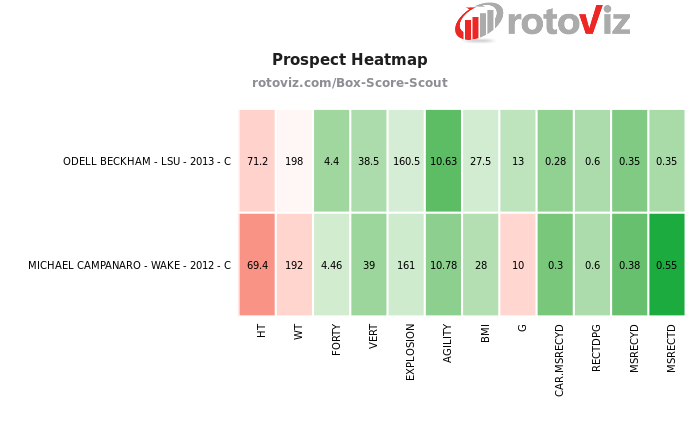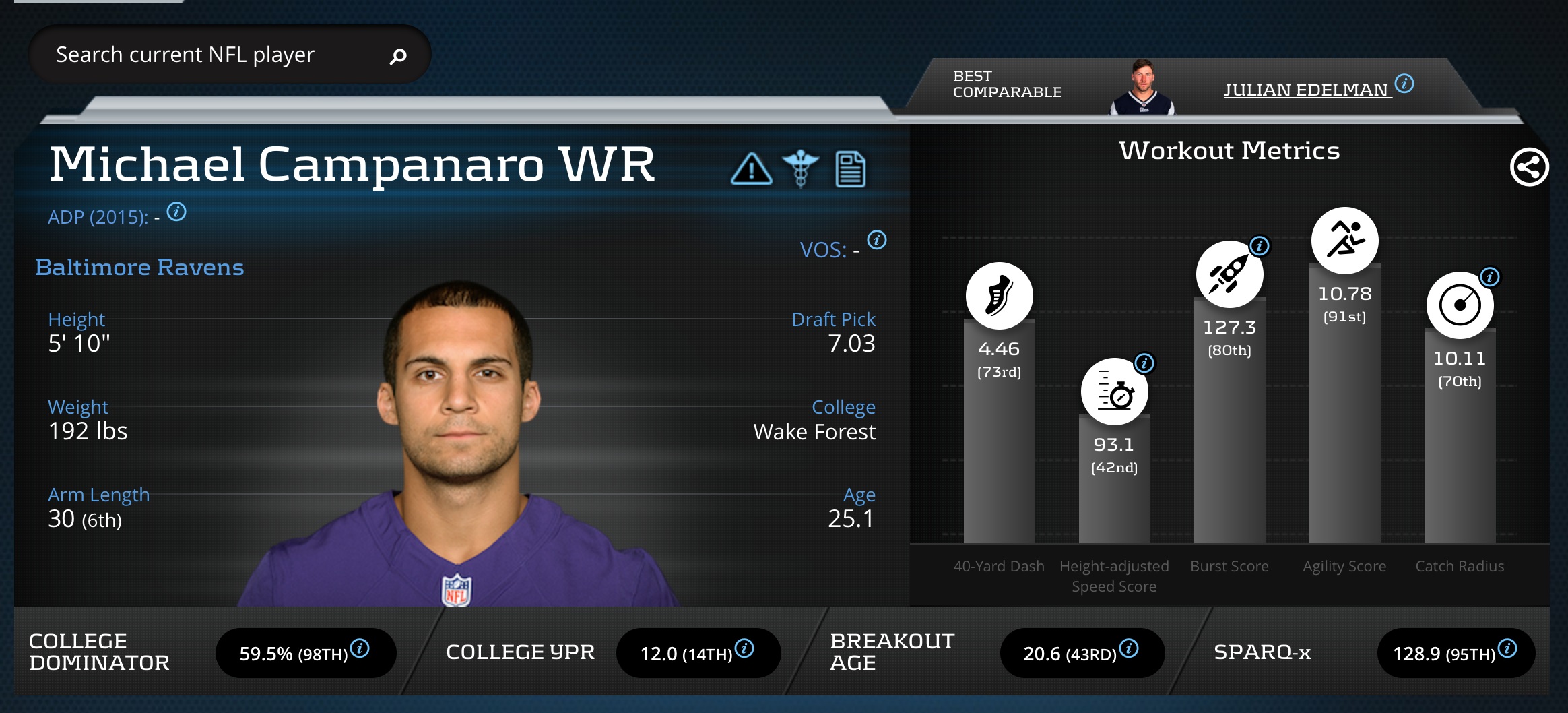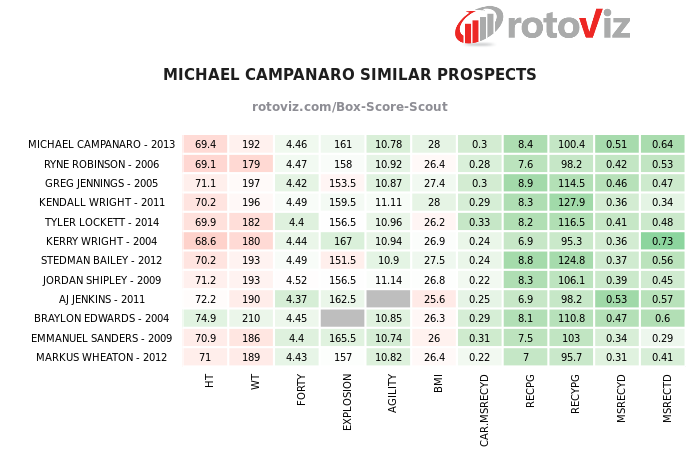Over the last few football seasons #TeamBigWR has advocated for the blanket devaluation of smaller athletes. The zeal to dismiss the 5-10 wide receiver from fantasy football consideration can be blamed on eye test bias — big receivers often look imposing and impressive next to their smaller counterparts. Beyond intuitive bias, I suspect that a well-documented fact that big wide receivers are generally undervalued eventually morphed into an oversimplified rule of thumb: avoid small wide receivers on draft day.
Armed with an all-encompassing “big or small” binary criteria, some influential fantasy footballers implemented flawed lifetime valuation processes — overweighting less important data points (e.g. height) while underweighting some more important aspects of a player’s profile (e.g. relative college production). The market soon overcorrected and heavily discounted the small wide receiver prototype. As a result, the 5-10 wide receiver has become undervalued over the last few seasons.
Expanding the Scope
We would all love to find the big, fast, utterly dominant wide receiver that checks all the boxes, but these all-around sexy picks are rare. A Julio Jones-type receiver has not entered the NFL since… Julio Jones. While uncovering the next Jeff Janis seventh round, size-speed specimen from Saginaw Valley State is immensely thrilling, setting the bar at Julio Jones, or even Jeff Janis, is arbitrary and myopic.
Recently we’ve seen smaller speed demons like T.Y. Hilton and John Brown find their niche in the league as the field stretching Split End and we’ve also seen precise route runners like Julian Edelman and Antonio Brown find success as their team’s flanker and occasionally in the slot. The key to finding these players is understanding the difference between their roles and understanding the measurables that best correlate with success in those roles.
A Prototypical Flanker Target Hog
Typically the flanker or Z-receiver is the best route runner on the team. Because they play off the line of scrimmage, it’s tough for the secondary to jam them up, giving them free release at the snap. These players don’t necessarily need deep speed but good quickness and explosiveness is essential.
I put more weight on College Dominator Rating (percentage of teams receiving production) with prospects that fit this role as it helps display the ability to be a target hog. Because the assumption is that smaller players are mostly “deep threats,” the athletes with high-volume slot-flanker traits are often overlooked.
I believe Michael Campanaro is one of these overlooked, undervalued future NFL flanker target hogs. While Campanaro missed multiple games during his final season at Wake Forest, in the games he played, he accounted for a mind-boggling approximately 60-percent of WFU’s receiving yards and receiving touchdowns. More precisely, a 59.5-percent (98th-percentile) College Dominator is one of the highest in the PlayerProfiler.com database among major conference wide receivers.
With the Rotoviz Box Score Scout App, we can put Michael Campanaro under the microscope to see if he has the DNA of a successful flanker. In my mind, the best way to do this is to use size and forty times to get comparable players, and then add Explosion Score, career numbers, most productive season and BMI because this role is dependent on breaking tackles like a running back and gaining yards after the catch.
I also added in Agility Score, because smaller receiver are often more adept at moving around the formation, and the slot-flanker target hogs of the past, from Wes Welker to Doug Baldwin, generally demonstrated exceptional lateral agility in workouts. This is where the term “slot-flanker” comes from.
Only 41 players in NFL history have caught 80 passes in a season at under 6-0. It probably doesn’t hurt that three of them are in this comp list. Sure, there are some unknowns and busts listed as well, but that tends to be the case with any prospect.
Now look at Michael Campanaro‘s junior season compared to Odell Beckham‘s :

Michael Campanaro vs Odell Beckham
Pretty damn exciting. Unfortunately, Michael Campanaro opted to return for his senior year and thus was buried under what many believe could be the greatest receiver class of all time.
2016 Opportunity
Apparently, Steve Smith‘s retirement has been put on the backburner for another season, but the parade isn’t flooded out just yet. At age 36, Smith was on pace for 167 targets over 16 games. Jerry Rice and Terrell Owens are the only players in the history of the NFL to receive 100 targets at age 37.
This does not necessarily guarantee that Campanaro will take over for the old man; coaches hardly ever make rational decisions. That said, it seems like he was starting to earn the team’s trust before his season ending injury:
“Under the duress and chaos of the game, he has made some plays,” Offensive Coordinator Marc Trestman said [of Campanaro] Tuesday. “So he certainly deserves to get more opportunities.”
Also working in Michael Campanaro‘s favor is the fact that no receiver who saw their snaps rise due to injury last year was able to post a positive production premium. Most importantly the de facto target leader Kamar Aiken ranked outside the top 50 in this area and was as ineffective as the Jordy Nelson-less Randall Cobb.
Polarizing first-round pick Breshad Perriman should finally be ready to get on the field but his size/speed combination and his 96th percentile college yards per reception would indicate he’s a much better fit for the Split End (X receiver) role.
Conclusion
I set out to discuss an underrated player in a good situation, but also to look at the reasons a player like Michael Campanaro becomes underrated or overlooked. I believe we have put the wide receiver position into one box, believing that the only thing separating a good player from a bad player is targets and what is done with each target. In actuality, the things we are looking for in a “good” receiver might not apply to all sizes and roles.
For example, while Devin Funchess was dismissed as a “tight end in wide receiver’s clothing” after slogging out a bottom percentile 40-yard dash time at last year’s NFL Scouting Combine, Funchess’ straight line speed is less relevant if Carolina installs him as a full-time flanker rarely running “go” patterns.
In the case of Michael Campanaro, few have him listed a sleeper du jour for 2016. However, when looking at his athletic profile, collegiate dominance, and projected role on offense, he will enter next season in an enviable situation, and is a top breakout candidate in both dynasty and redraft fantasy football formats.
Today, Michael Campanaro is more than just a smaller wideout with a great profile. He might be the next Julian Edelman.




